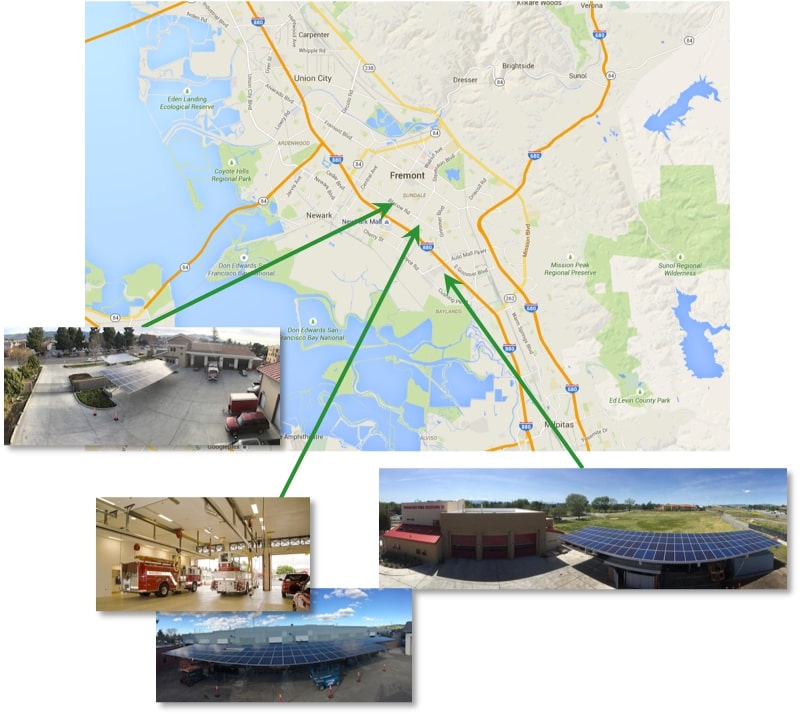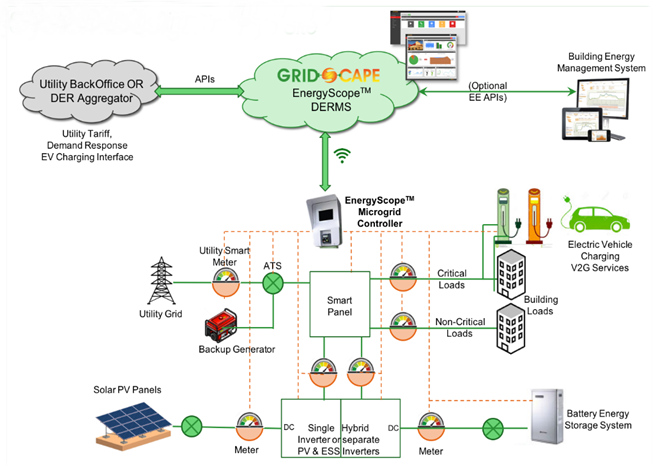Connected, Controlled and helping the critical facility
Case study – Fremont Fire Station
Critical facilities are especially vulnerable to climate change impacts that disrupt the normal delivery of electricity necessary for their operation.
Fremont is physically located on top of the Hayward fault line making it earthquake prone. In case of any natural disaster, Fremont city emergency services such as fire, paramedics and police, must be prepared, self-sufficient and fast to respond relying on their own power. The fire stations in the City of Fremont became an obvious choice for a local sustainable power plant (microgrid).
Critical facilities getting resilient power supply with local renewable power plant (microgrid):
Gridscape partnered with the City of Fremont, Delta Products, Sun Light and Power, Microgrid Energy, and Pacific Gas and Electric Company (PG&E) to design and install microgrids at 3 fire stations. The CEC EPIC funding provided 75 percent of the capital investment for this project, with Gridscape investing the remaining 25 percent of the capital investment as match funding.
Image Credit: CEC
About the California Energy Commission:
CEC is the state’s primary energy policy and planning agency. Created by the Legislature in 1974; its responsibilities include forecasting energy needs, promoting energy efficiency, supporting the renewable energy market etc. Within the last two years, the most important development in California’s energy policy has been two landmark pieces of legislation for energy policy that focus on climate change and transportation.

Why microgrids make sense for Fremont?
- Resilient power supply: A large city like Fremont, which is highly populated and includes critical facilities like fire stations, need to have power supply 24×7 to keep various facilities running since they are critical community resources. A microgrid can provide such cities resilient, consistent power supply.
- Savings: It also helps cities and neighbourhoods in cost savings since cities are always working under strict budgets and can help them meet their climate action plan and this sets an example for others, helps create awareness and become a model for other cities and critical facilities to follow.
- Low carbon footprint goal: The global electricity demand will increase dramatically in the years to come (by 44% in 2030 in comparison with 2012 – IEA), cities need to provide access to energy but also keep the carbon footprint low.
- Fleet electrification: Prepare the city to take the load from EV.
- Improved quality of life: With green jobs, more employment opportunities, local sustainable power plants (microgrids) provide Financial, Resilience, and Social Benefits.
Benefits to California
This project demonstrates the replicability and economic feasibility of solar emergency microgrid installations at critical facilities across the state and paves the way for mass use of this technology across the state.
This project led to the design and development of a cost-optimized microgrid controller and value-engineered design for a microgrid targeted for small to medium critical facilities. This invention along with declining prices of solar photovoltaic systems and battery systems opens up a unique market opportunity to companies such as Gridscape to replicate and commercialize these systems for mass adoption. This benefit itself can be considered the greatest achievement of this project.
Gridscape intends to commercialize the microgrid solution developed in this project and market it across various prospects in the small to medium municipal, commercial and industrial markets and university, school and hospital markets in California and globally.
*Image Credit: California Energy Commission
Gridscape employed a value-engineering approach in this project to optimize the design, construction, and cost of the microgrid controller and DERMS system to address the specific requirements of this market.
The following additional results of this project will benefit the state of California as well:
- Reduced annual greenhouse gas emissions in Fremont and California by 141,896 pounds, thereby supporting the goal of Assembly Bill 32 (Nuñez, Chapter 488, Statutes of 2006).
- Contributed 205,000 kilowatt-hours of clean energy generation during the demonstration period and is expected to produce more than 1,750 megawatt- hours of clean power over the 10-year useful life of the project, thereby contributing to achieving California’s Renewables Portfolio Standard goal of 33 percent renewable energy sources by 2020 and 100 percent carbon-free energy sources by 2045.
- Will create and maintain clean energy jobs.
Benefits of a microgrid:
Microgrids can provide several benefits to the cities, critical facilities. These benefits are particularly important to cities, which strive to create safe, livable communities with thriving economies.
- The global electricity demand will increase dramatically in the years to come (by 44% in 2030 in comparison with 2012 – IEA), cities need to provide access to energy but also keep the carbon footprint low.
- Aging grids and infrastructure- Climate change and increasing frequencies of natural disasters are putting a lot of pressure on the traditional grids.
- Cities need to accommodate the massive pressure coming from EV.
- Microgrids Provide Financial, Resilience, and Social Benefits.
Local sustainable power plant is the answer:
About Microgrid:
Microgrids are localized energy grids or a a self-contained power system that help facility owners take control back from the traditional grid, maintain a stable flow of power, and lock in utility rates.
One or more types of distributed energy (solar panels, wind turbines, cogeneration, generators) are used to generate electricity within microgrids. Furthermore, many new microgrids have energy accumulators, which are often batteries. Electric vehicle charging stations are also available.
Local, self-generation of power can be great for anyone who wants control over energy costs.
About Gridscape:
Gridscape is the largest and a well-established name specializing in developing and deploying standards-compliant future-proof products and solutions for renewable energy microgrids and fleet charging. Intended to serve as a locally produced sustainable power plant, these microgrids allow sites to become less reliant on the grid by using local sources of energy. They can provide as much as 90% independence from the grid energy, and thus reduce overall energy cost & provide backup clean emergency power during PSPS or other power disruption events. Gridscape with its ‘Product Centric’ approach to microgrids integrated with fleet EV charging solutions allows for lower cost of installation and reduces the time for deployment by substantially lowering integration issues. It expects to deploy and operate over 35 microgrids in California public and commercial facilities over the next 12 months. The list of Gridscape’s microgrid and EV charging customers and partners is as follows:
Unlike traditional microgrid developers, Gridscape employs a holistic product-centric, artificial intelligence (AI) based software-driven approach to designing, deploying, and managing microgrids. It also integrates Electric Vehicle (EV) charging and other controllable loads into its solution. Through its broad partnerships with various Tier 1 and Tier 2 financiers, design engineering firms, energy storage manufacturers and other renewable energy product providers, it leverages the best-in-class mix of technology and finance to provide maximum return on investment to customers.
Gridscape’s solution is unique, and it differentiates from traditional systems in following manner.
Product Centric Approach (vs Project Centric Methodology) for scalability, maintainability, and longevity of microgrid assets
Software driven architecture resulting into no technology obsolescence and ability to adapt to changing PG&E tariffs and distribution grid conditions.
Dynamically configurable with an ability to change the microgrid operational modes on demand
Energy Information System: A cloud-based distributed energy resource management system (DERMS) that includes
1
Smart AI-based energy management and optimized load and generation dispatch; and
2
Very powerful visualization dashboard for accessing real time and historical data about PV, Storage and EV charging stations.
Inherently Integrated with EV charging infrastructure
Full Energy Management including demand charge reduction, TOU arbitrage, grid services.
Integration with various Cloud platforms such as Google, Amazon for grid services and load management.
Gridscape EnergyScopeTM Dashboards


Three Fire Station Demonstration Sites in Fremont
The Project
The project team carefully selected three fire stations as demonstration, based on factors including geography, energy usage, age of the buildings, minimum disruption to fire operations, show replicability and ease of access for research and development purposes. It was decided early on that the project team would deploy the first microgrid at one station (Fire Station 11) first, and then in the remaining two. The reason for this decision was to ensure that lessons learnt, especially technology and cost improvements, from the first site could be applied at the remaining two sites.
The project team performed exhaustive testing and data collection for a period of 12 months on the microgrid at Fire Station 11, and subsequently for approximately 4- 6 months on the remaining two stations. The results of this testing and data collection helped establish the achievement of the original goals and objectives of the project. Gridscape also undertook an exhaustive design and prototype development upfront to carefully select the right components for the system in order to meet technology costs, performance attributes and other technical features of these microgrid systems.
A Technical Advisory Committee (TAC) was formed to advise the project team and to ensure it made the right design choices to meet important technology, cost and performance attributes of the system. The TAC team constantly advised the project team on short-term project objectives, as well as long term market traction of these systems during the course of the project
Design
The project will be based on following figure system integration architecture for Gridscape projects with minor modifications/ alterations.

Typical System Integration Architecture
Results
The project was completed in four years and yielded better than expected results. First and foremost, the project team was able to exceed the anticipated results by a factor of 25% across all metrics, as summarized below.
1.
The project has saved $7,046 in energy costs over the 12-month demonstration period at Fire Station 11 and is expected to save more than $30,000 a year collectively over all three fire stations, and over $300,000 over a 10-year period. This result is 25% better than original expectation.
2.
The project team executed 4 islanding tests during the demonstration period. Each test lasted more than three hours consistently. The last islanding test lasted for more than 13 hours. The original goal was to demonstrate at least three hours of islanding.
3.
The project has also met the GHG emissions reduction goal of 80,000 lbs/year during the demonstration period. This achievement helped the City of Fremont meet its climate action plan objectives as well.
4.
The project team was able to achieve a technology cost reduction of more than 30% from the first microgrid at Fire Station 11 to the remaining two at Fire Stations 6 and 7, by adopting value-engineering and cost optimization measures.
5.
The project also supported the design and development of a microgrid controller and a cloud-based advanced visualization, control and management platform as shown in Figure for distributed energy resources for small to medium critical facilities and C&I market spaces.
6.
The project paved a way for Gridscape to commercialize the technology and solutions developed for mass market adoption and proliferation in the small to medium municipal and C&I market segments in California and beyond. Gridscape is now deploying several microgrids at critical facilities and various C&I customers.
Conclusion
The project team faced several challenges and barriers, such as utility interconnection, construction delays and other technical, legal, and regulatory agreement issues. Most of these challenges were overcome with design changes, negotiations, and improvements made throughout the project as described in this report. Challenges and obstacles faced in the development of the first Fremont Fire Station microgrid system allowed our team to anticipate relevant problems throughout the process and become more cost-efficient as each project was completed.
*Image Credit: California Energy Commission
